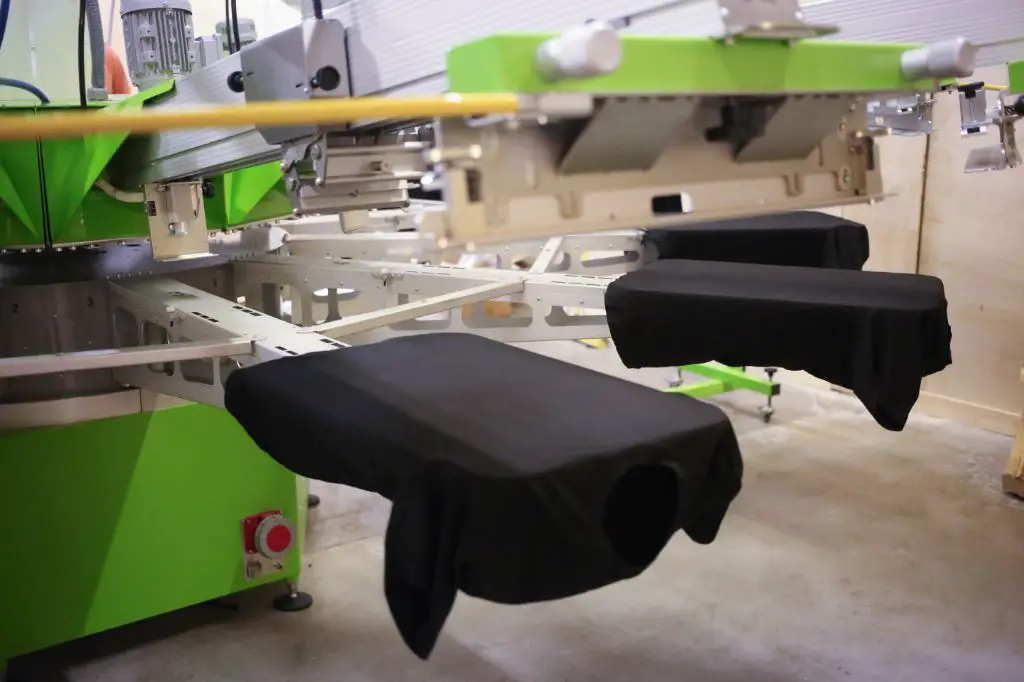Is Silk Screen Printing Good Or Bad?
Silk screen printing, also known as screen printing or serigraphy, is a printing technique that originated in China over 2,000 years ago. The earliest records of silk screen printing date back to the Song Dynasty in China (960–1279 AD). Silk nets were used as screens to create patterns on fabric. The technique eventually spread to Japan and other Asian countries.
Silk screen printing came to the United States and Europe in the early 1900s. It became widely used for commercial printing and artistic prints. The technique involves using a woven mesh screen coated in a light-sensitive emulsion. A stencil is created by blocking off parts of the screen that need to remain ink-free. Ink is then pushed through the open areas of the mesh using a squeegee, transferring the image onto the material underneath. Silk screen printing allows for printing on a wide variety of materials like paper, plastic, glass, metal and more.
Environmental Impact
Screen printing uses various inks and chemicals that can have negative environmental impacts. The majority of screen printing inks contain solvents that evaporate into the atmosphere and contribute to air pollution. Many of these solvent-based inks also contain volatile organic compounds (VOCs) like benzene and toluene, which are known carcinogens and can be harmful to human health (1).
Some water-based inks have been developed as an alternative, but they may still contain some solvents or other potentially hazardous ingredients. The cleaning chemicals used in the screen reclamation process also create waste that requires proper disposal (2). Some options to make screen printing greener include using low-VOC or water-based inks, recycling screens, and safely disposing of chemical waste (3). Overall, screen printing does carry notable environmental risks from solvent emissions and chemical waste.
Sources:
1. https://www.atitextile.com/environmental-impact-digital-print-vs-screen-print/
2. https://screenprintingmag.com/sustainability-in-the-screen-printing-world-its-complicated/
3. https://www.screenprinting.com/blogs/news/how-to-do-eco-friendly-screen-printing
Cost
The startup costs for silk screen printing equipment can be significant, especially for small businesses or beginners. Some of the main equipment needed includes the screen printing machine, screens, squeegees, inks, and curing methods like conveyor dryers or flash units. A basic starter kit with a small manual press, screens, inks and other supplies can cost $500-$1,000 (https://www.screenprinting.com/collections/silk-screen-printing-kits-and-packages). More advanced automatic presses range from $2,000 for small format presses up to $10,000+ for industrial machines (https://lawsonsp.com/collections/screen-printing-equipment). Ongoing costs for supplies like inks and emulsions also need to be factored in.
For small businesses with lower print volumes, outsourcing printing through a contract printer may be more affordable than investing in equipment. But for higher volumes, owning equipment can become more cost-effective long-term. Proper equipment selection based on print volume needs is important to balance startup costs versus ongoing printing costs.
Quality
Screen printing allows for a higher quality print than other methods like direct-to-garment (DTG) printing. Screen printed designs have better resolution and sharper edges because thick inks are pressed through a mesh screen directly onto the garment.
Screen printing also provides much better color reproduction. The inks used in screen printing are opaque, allowing for vivid colors and designs not possible with dye-based inks used in DTG printing. With screen printing, designs really pop on the garment with bright, solid colors.

According to Real Thread, “Screen printing has many pros, the first being the high quality of the print. Your t-shirt prints will be more vibrant in color compared to DTG printing methods.” The high print quality of screen printing makes it well-suited for branding, event merchandise, bands, and more.
Versatility
One of the biggest advantages of silk screen printing is its versatility and ability to print on a wide variety of materials. Screen printing is commonly used for printing on fabric, especially t-shirts, but it can also be used to print on many other surfaces like cardboard, wood, and tote bags. The ink binds to the top layer of the material, so it adheres well to smooth, absorbent surfaces. Screen printing has been used to print designs on fabrics like cotton, polyester, nylon, and silk. With proper technique and setup, screen printing can be done on delicate fabrics like silk as well as thicker materials like canvas bags.
The wide range of materials that can be used make screen printing a very versatile printing method. Print shops and artists are able to produce custom prints on substrates that other printing methods can’t handle as well. This creative potential is one of the biggest appeals of screen printing.
Creativity
One of the main benefits of silk screen printing is the immense creative potential it provides. With silk screening, almost any image or design can be reproduced on a wide variety of surfaces like fabric, plastic, glass, metal, and more. This opens up endless possibilities for customization and creativity.
Unlike technologies like screen printing or inkjet printing that rely on CMYK inks, silk screening uses specialty inks that allow for metallic colors, neon colors, glow-in-the-dark effects, and other unique options not possible with digital printing. The use of specialty inks greatly expands the creative possibilities.
Silk screening is ideal for complex and colorful designs with fine details that digital printing cannot always reproduce accurately. With precision cutting and masking techniques, silk screen printers can recreate photographic images, illustrations, and complex graphic designs.
According to Creative Silkscreen, “Where art and machine come together, that’s where the magic happens.” Silk screening allows artists, designers, and creators to bring their visions to life on an endless array of surfaces and products.
The highly customizable nature of silk screening makes it possible to print completely original, one-of-a-kind designs in small or large quantities. This combination of customization and scalability empowers creativity.
Durability
One of the major benefits of silk screen printing is its excellent durability and fade resistance. According to Epromos, screen printed T-shirts can withstand between 40-50 washes in the machine before fading or cracking occurs. The specially formulated inks used in screen printing are designed to bond securely with the fabric fibers, creating a print that lasts for years with proper care.
Screen printing results in a thicker application of ink, around 0.5mm on average, compared to other printing methods like heat transfer. This added thickness makes the print more resistant to fading and cracking over time. The ink is cured at a high temperature which chemically bonds it to the fabric for maximum washability. Screen printed fabrics can be machine washed and dried without losing vibrancy or integrity of the image. Proper heat curing is essential for making screen printed fabrics as durable and long-lasting as possible.
Overall, the durability and fade resistance of silk screen printing far exceeds that of other printing methods like heat transfer or inkjet printing. Screen printing is the go-to choice for creating customized t-shirts, apparel, posters and other items that need to withstand repeated use and washing over many years. When done correctly, screen printed designs will remain vibrant and intact for the lifetime of the garment.
Profitability
Screen printing can be a very profitable business opportunity with the right plan and execution. According to Screenprinting-ASPA.com, a good screen printing company can be very profitable right out of the gate, with worker salaries and employer annual sales at impressive levels. Many successful screen printing business owners share that with the right business plan focusing on efficiency, quality, and marketing, the profit margins in screen printing can be quite substantial.
Some key factors that impact profitability in the screen printing business include efficiency of operations, pricing and cost control, marketing and sales, and managing overhead costs. Automation and streamlining workflow can help improve efficiency. Understanding cost of goods sold and calculating appropriate pricing is also critical. Developing a marketing plan to reach the right target audience and generate ongoing business is essential. And minimizing overhead costs like rent and labor where possible helps keep more profit. With some business savvy and effort, screen printing can offer exciting income potential.
Limitations
Silk screen printing has a number of limitations compared to other printing methods. First, the quality is generally lower than other techniques like offset printing or digital printing. The ink sits on top of the fabric rather than being absorbed into the fibers, so the prints have a tendency to crack and fade over time (TextileApex). The printed image also lacks fine detail and the ability to reproduce delicate gradations in tone.
Another major limitation is the number of colors that can be printed. Most silk screen jobs are limited to 1-4 colors maximum. The more colors used, the greater the setup time and cost. This makes it impractical for printing designs with full photographic color images. There are also limitations printing on curved or unusually shaped surfaces compared to digital printing which can print on almost any material (Evans Graphics).
Overall, while screen printing excels at bold graphical designs in 1-2 colors, it lacks the color range, detail, and flexibility of other printing methods.
Conclusion
In assessing the pros and cons of silk screen printing, there are good arguments on both sides.
On the pro side, silk screen printing allows for high quality, creative, and durable prints at relatively low costs. The technique is extremely versatile, allowing printing on a wide variety of materials and objects in any size. For artists, small businesses, and entrepreneurs, silk screen printing provides an accessible and profitable option for producing customized apparel, posters, and more.
On the con side, silk screen printing does have some environmental impacts due to use of inks and solvents. The setup process also requires some technical skill and equipment. For extremely high volume orders, digital printing or offset printing may be more efficient options. And fine detail or photographic images can be difficult to reproduce well with silk screening.
Overall, for most small to medium jobs requiring customization, creative designs, and printing on non-traditional surfaces, silk screen printing remains an excellent choice. With care taken to use environmentally-friendly inks and proper disposal, the benefits seem to outweigh the drawbacks for most applications.




